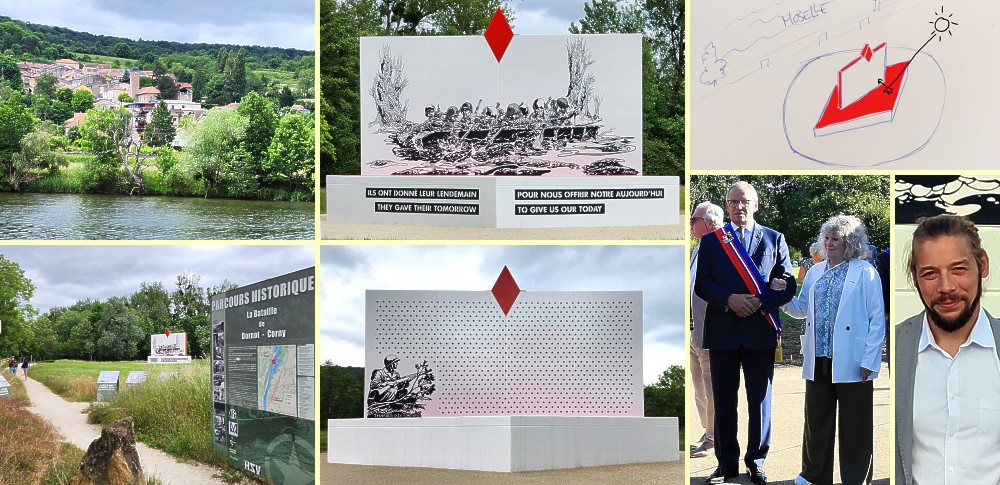Kansas Snapshots by Gloria Freeland - July 4, 2025
Thanks GIs
The path along the river's grassy edge is peaceful. We occasionally meet a walker or someone on a bicycle enjoying the sunny day. A
faint rumble draws our attention to a train passing behind the trees on the opposite shore 400 feet away.
But September 8, 1944 was a very different day. The Moselle was flooding from days of rain. The sky was overcast. Making their way
from the small village of Dornot to the river's eastern edge were 1,200 soldiers of the 11th Regiment, 5th Infantry Division. They
were to cross in small boats, assemble in what would come to be called Horseshoe Woods, and then turn northward to attack the heavily
fortified city of Metz, France.
But there were two camouflaged forts in the high ground on the river's east side. The Germans waited patiently until most GIs had
crossed. They would then be caught between the forts' withering fire and the flooding river.
The battle raged for 60 hours. Some made it back, but 945 died or went missing.
It was a disaster, but a crossing needed to be made. A few days later, another attempt farther south and away from the forts,
succeeded in reaching the village of Corny on the eastern shore.
While few Americans today are aware of these events, members of the "Thanks GIs" association have not forgotten. Founder and
president Elisabeth Gozzo said it was formed "to continue to honor the memory of our American liberators, and hopefully to find
others missing in the Horseshoe Woods."
She became interested while translating statements of U.S. veterans for the mayor of a village who was writing a history of his
community.
... I was overwhelmed by these testimonies, and I threw myself into it completely. ... Then, I learned that an American veteran had
returned to Corny. I wrote to him, and a wonderful love story was born between him and his children and me. He signed all his
letters: "Your American Papa." Since then, his nine children have called me "Sister ..."
She wrote to other veterans in the 5th Infantry Division and five attended the inauguration of their initial memorial in September
1998.
Today, the path is lined by the plaques placed and maintained by the group. They contain descriptions of the battle, photos, maps,
sketches, and quotes from survivors.
We had visited before, but French friends encouraged us to return to see the newest addition.
We were struck by its sheer size. The 300-ton memorial is 45-feet wide and 26-feet tall. On the side facing Dornot is a depiction of
the soldiers crossing the Moselle. A quote in French and English describes the men’s sacrifice: "Ils ont donné leur lendemain pour
nous offrir notre aujourd’hui - They gave their tomorrow to give us our today."
The east-facing side has 945 stars - one for each person killed or missing, along with a silhouette of a soldier on the shore and
the words, "Thanks GIs."
A red diamond, the insignia of the U.S. 5th Infantry Division, sits atop the monument and a larger one provides its base.
Gozzo said in 2004, survivor Nick Pokrajac of the 7th Engineer Battalion, gave the group about $100,000 to establish something
permanent to immortalize the men who fought there.
"So, we worked, and worked, without ever touching Nick's money, until we came up with the idea, designed, and funded a memorial,"
she said. "It was an epic adventure!"
Artist Éric Chapuis met the group in 2018 and began designing the memorial in 2021. He has worked in film production design,
animation, comic books and more. He said whatever medium he uses, the essence of his work remains the same - telling compelling
stories.
"I'm very close to comics and illustration, and I knew that Jack Kirby had participated in the battle, so the idea of a mural on the
wall came naturally," he said.
Kirby, one of the co-creators of comic-book super-hero Captain America, was a survivor of Horseshoe Woods and his war-time
experiences influenced his work.
"For the overall shape, I was inspired by a symbolic compass," Chapuis said. "Seen from the air, this monument indicates the
[location of] various actors in the battle."
He said the project consisted of four teams of specialists and office staff, totaling around 50. The wall was built in four months,
the cutting of the metal mural pieces took three months, and the mural installation took one month.
"... A metal mural of this size, with this complex puzzle, is a first in France. ..."
I asked whether the red color I had noticed in the water of the mural represented the blood of the soldiers lost.
Yes, we can see it that way. It's the reflection of the sun on the base that gives it this color; the red of the base colors the
mural in a very beautiful play of colors. It's subtle, sensitive, and the intensity of the color changes depending on the weather.
The weather was bad during the battle, the sky was covered with clouds. I wanted to convey the idea that, in the fury of combat,
there's no way to appreciate the intensity of a massacre. It's invisible. We only see the reality when calm and light return.
I chose red to give an indication from the air as well. The monument is in the middle of a green field populated by trees. The
compass is therefore extremely visible from the sky. Like a focal point.
On September 8, 2024, the 80th anniversary of the battle, more than 1,000 people attended the memorial's dedication, including
an American honor guard, U.S. and French officials, and descendants of veterans who fought at Dornot-Corny.
Eighty years may have passed, but Thanks GIs and other French citizens still remember the sacrifice of our soldiers.
